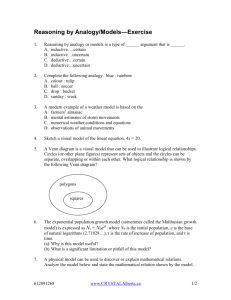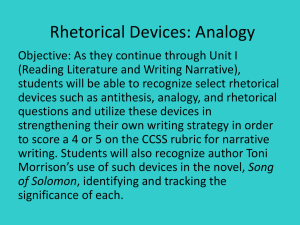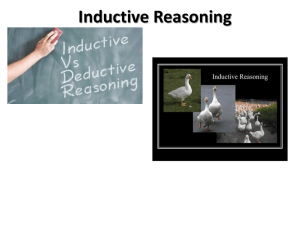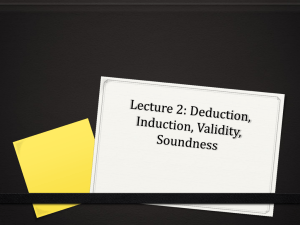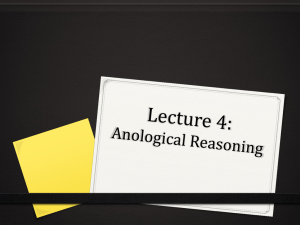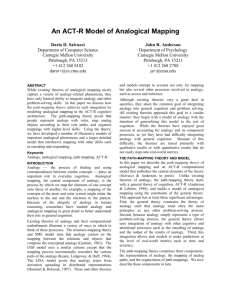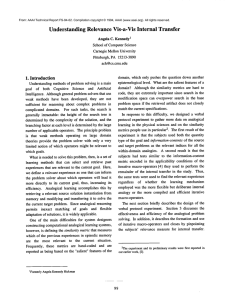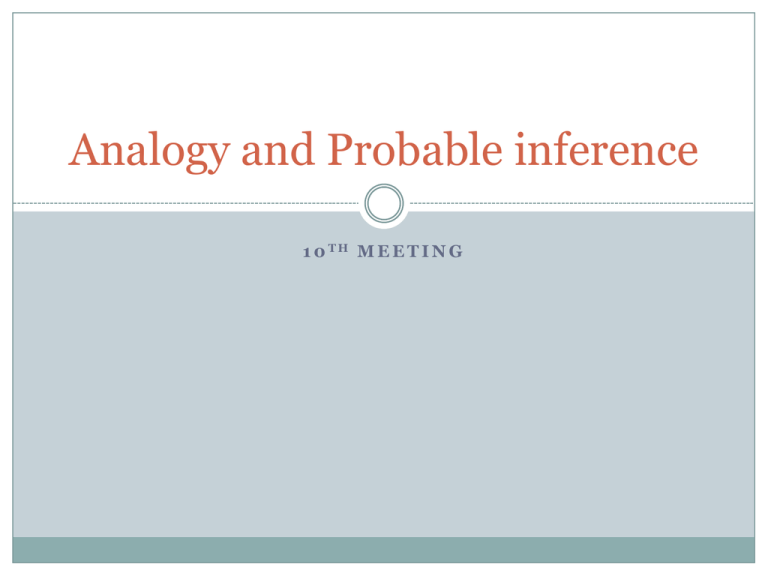
Analogy and Probable inference
1 0 TH M E E T I N G
Definition
Analogical argument is one of the most kind in the
analysis of inductive argument
Analogy is relationship between one and others
based on likeness and similarity or comparison
We draw an analogy when we indicate one or more
respects in which two or more entities are similar.
An argument by Analogy
An argument by analogy is an argument in which the
similarity of two or more respects is used as
premise(es); its conclusion is that those entities are
similar in some further respect.
Exercises
Distinguish the analogies that contain analogical
arguments from those that make nonargmentative
uses of analogy.
1. A Man ought no more to value himself for being
wiser than a Woman, if he owes his Advatage to a
better Education, than he ought to boast of his
Courage for beating Man when his hands were
bound (Mary astell, An Essay in defence of the
Female Sex (1721), quoted in Germaine Greer, The
Female Eunuch)
2. The brain secretes thought as the stomach secretes
gastric juice, the liver bile, and the kidneys urine.
(Karl Vogt, Koblerglaube and wissenschaft)
3. .... It astonishes me that the exploitation of women
should be no readily accepted. When one thinks of
the ancient democracies, deeply attached to the ideal
of equality, it is difficult to see how they can possibly
have thought the status of the slaves natural: anyone
would suppose that the contradiction must have
been glaringly obvious to them. Perhaps one day
posterity will wonder with the same astonishment
how the bourgeois or popular democracies of our day
can conceively have maintained as basic inequality
between the two sexes, and have maintained it
without the lest qualm of conscience
4.Thinking is experiemental dealing with small
quantities of energy, just as a general moves
miniature figures over a map before setting his troop
in action. (Sigmund Freud, New Introductory
lectures on Psychoanalysi)
5. One of the pleasures of science is to see two distant
and apparently unrelated pieces of information
suddenly come together. In a flash what one knows
doubles or triples in size. It is like working on the
large but separate sections of a jigsaw puzzle and,
almost without realizing it until the moment it
happens, finding that they fit into one (John Tyler
Bonnerm “Hormones in social Amoebae and
Mammals” Scientific American, vol.221, November
1969)
The use of analogy
Not all analogies are used for purposes of
explanation. They may also serve for literary effect,
or for purposes of explanation.
Example of literary effect: A poem withe the title a
letter to a friend, by Yumarma (June 25, 1982)
Because of analogical arguments are inductive, not
deductive, not deductive, the term validity and
invalidity do not apply to them.
The conclusion of analogical argument has some
degree of probability but is not claimed to be certain.
6 criteria
The number of entities between which the analogy is
said to hold
The number of respects in which the entities involved
are said to be analogous
The modesty (or boldness) of its conclusion relative to
its premises
The number of dis-analogies between the instances
mentioned only in the premises and the instance
mentioned in the conclusion
The degree of dissimilarity among the instances
mentioned only in premises
The relevance of the respects mentioned in the
premises to the respect mentioned in the conclusion
Refutation by logical analogy
An effective method of refuting arguments, both
inductive and deductive. To show a given argument
mistaken, it compelling to present another
argument, obviously mistaken that is identical in
form to the argument under attack.

